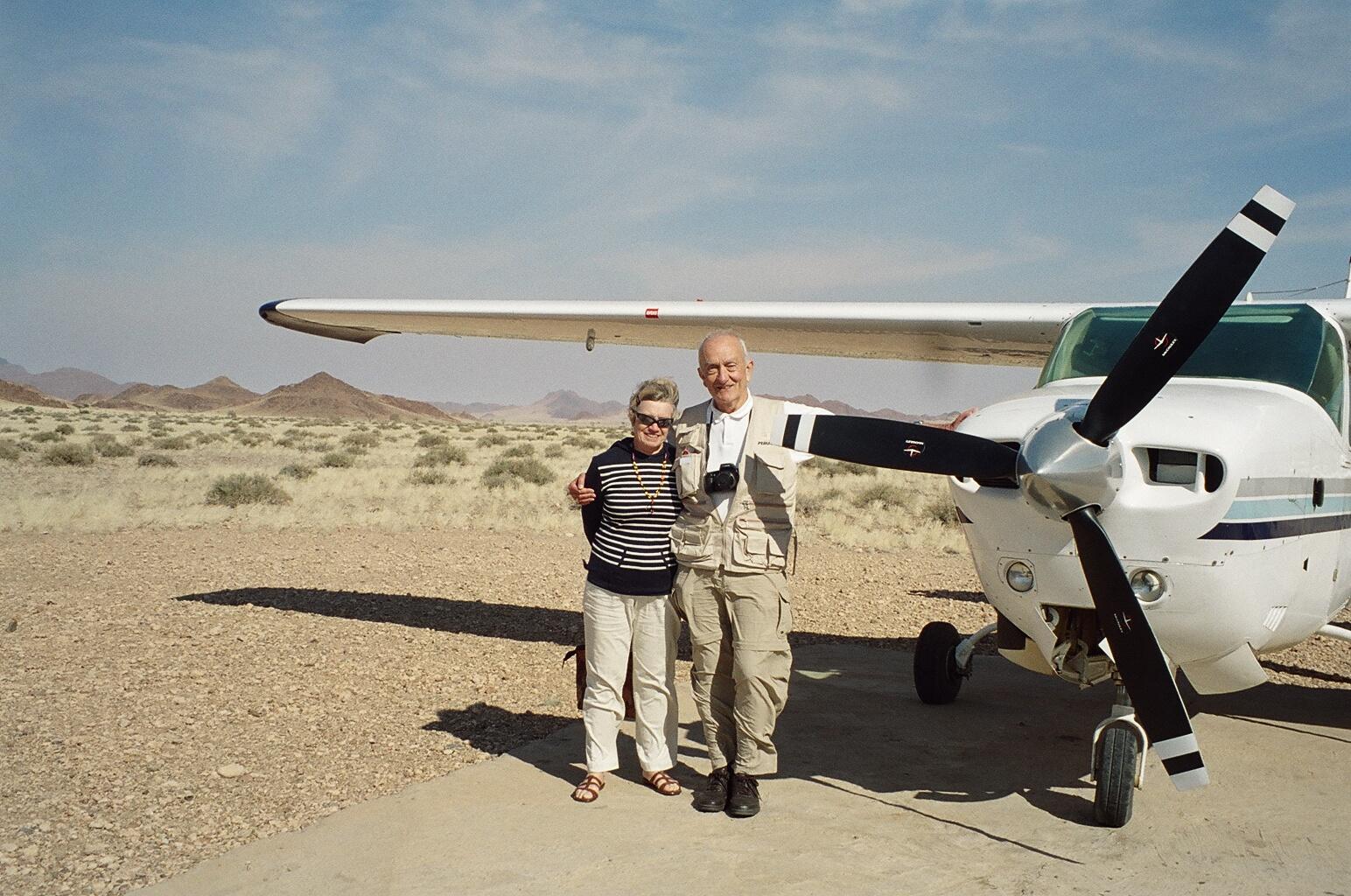
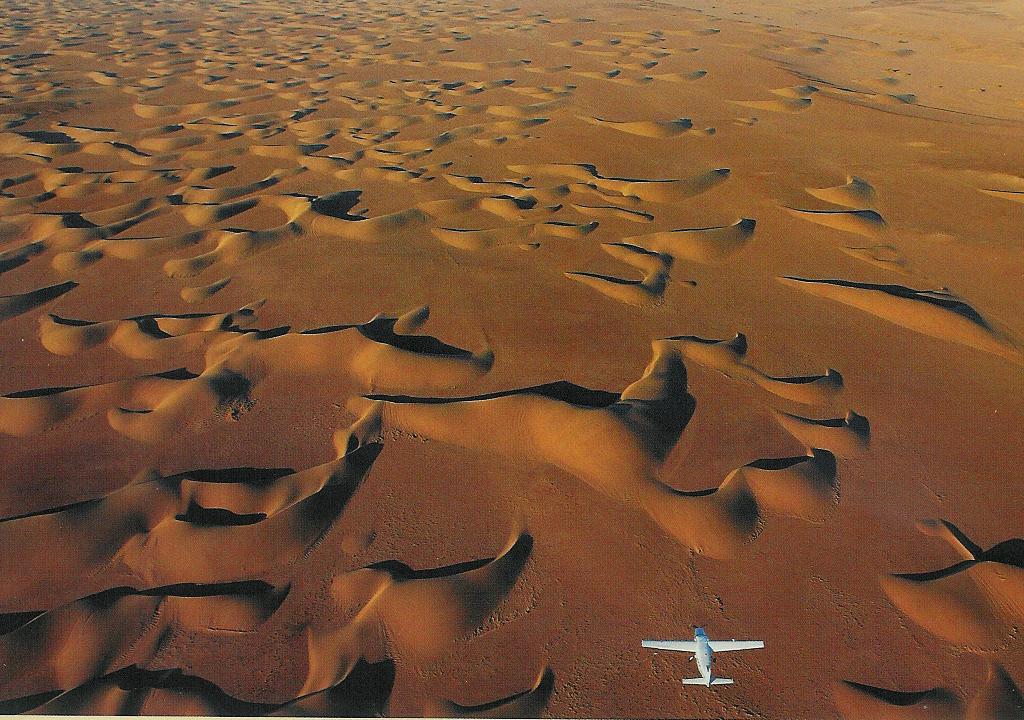
South Africa, Namibia (2005)
Wings over Africa
We spent our first week in Africa on a flying safari to several remote bush camps in Namibia before joining up with Ron and Gay Baukol in South Africa for a land safari adventure to Kruger National Park and Durban. It was our third time on safari in Africa; all three times with the Baukols.
 |
 |
Landing Strip, Sossesvlei Bush Camp Wings Over the Namib Desert
Unlike some of the more popular safari destinations of Africa with their trees, lakes, rivers and green savannahs, Namibia is marked by vast empty plains, isolated mountains and massive sand dunes. It is Africa’s southwest desert country framed by the Kalahari Desert in the East and the Namib Desert in the West and bordered by the bleak and inhospitable Skeleton Coast, which stretches three hundred miles along its Atlantic shores. Namibia has a unique, hostile beauty all of its own, highlighted by the scenic grandeur of the giant, red sand dunes of the Namib.
The animals which populate this region have adapted to their desert surroundings through the centuries, most notably the desert elephants and rhinos, which roam through the dry river beds. Sadly, the once large herds have been decimated as a result of the lack of an effective wildlife management program, which has only just recently been put in place.
Originally home to the Bushmen, the fascinating, tiny hunter-gatherer San tribesmen, for over thirty thousand years, the country was colonized by the Germans in the late 19th century. Following the German defeat in World War I, German West Africa was taken over by the Republic of South Africa, in effect replacing one colonial ruler with another. Namibia became an independent nation in 1990 following a twenty-two year war of independence. Namibia is one of the least densely populated counties in the world with only 1.5 million people in a country two times the size of California. In order to see as much of the county as possible, we arranged for a winged safari, with our own pilot and light aircraft to take us from one end of the country to the other. Not only was this the most practical way to travel across this large country but it also afforded some spectacular birds eye views of Namibia’s incredible geography.
Namibia. We spent our first and last nights in Namibia in Windhoek, the capital city, staying in a hundred year old German castle overlooking the city, an elegant reminder of the city’s German heritage. After a day to rest and repack our bags for the safari, we met our pilot at the airport early Sunday morning.
Our pilot was a 21 year old Namibian of Afrikaner descent. The plane was a single-engine, Cessna 210 with room for the pilot, five passengers and limited luggage. Our very compatible traveling companions were a charming French Canadian couple from Montreal and a spry World War II veteran from the U.S. Our little group, the pilot and the plane remained together for the entire week.
Our flights took us first to the Namib Desert in the South, west to Swakopmund and Walvis Bay on the Atlantic, up along the Skeleton Coast, inland to the highlands of central Namibia and finally north to the great Etosha plains. Each of the legs took from one to two hours of flying time. We generally flew at five thousand feet above the ground for sweeping views of the incredible scenery. Particularly fascinating was our low level flight up along the Skeleton Coast, where we flew along at five hundred feet above the coastline spotting abandoned diamond mines, massive seal colonies, flocks of pink flamingoes and the skeletons of old shipwrecks washed up on the beach, which gave this desolate stretch of coastline its name.
The spectacular views from the air plus the exhilaration of flying in a small plane made traveling to our destinations almost as much fun as being there. Approaching each of the bush camps, our pilot dropped the plane to treetop level and buzzed the camp, thus announcing our arrival and alerting the staff to send the Land Rovers out to the nearby dirt landing strips to meet us.
Our three wilderness camps were located in: Sossusvlei in the heart of the red dunes of the Namib Desert; Damaraland in the remote central highlands; and Ongava near Namibia’s large game park in Etosha. Two of the three camps were tented camps; the Sossusvlei camp had native-style huts with thatched roofs. None of the camps had more that ten units which limited the camp capacities to a maximum of twenty guests. Although rustic, they incorporated all of the creature comforts like flush toilets, hot showers and comfortable beds along with some nice extra amenities such as plunge pools for cooling off after a hot day in the desert, hot water bottles for the cold nights and hot tea brought to the tents each morning. Food was served in the main tent and was excellent, often featuring local game delicacies such as kudu and springbok. The camps were generally located near water holes offering up close viewing of the local game, including oryx, kudu, hartebeest, waterbuck, springbok and steenbok and even rhinos and lions, from our tents.
Our activities were tailored to the specific locations. In Sossusvlei, we took a pre-dawn drive into the heart of the desert arriving just as the sun rose, illuminating the brilliant red sand dunes, which in contrast with their black shadows created striking geometric patterns like intricate modern art paintings. The dunes, which were formed by winds blowing the sands up from the sea coast for thousands of years, are considered the oldest and highest dunes in the world, some rising to heights of over one thousand feet. Leaving the camp the next morning, we had a chance to fly over the dunes to see them a second time from the air, a truly unforgettable sight.
 |
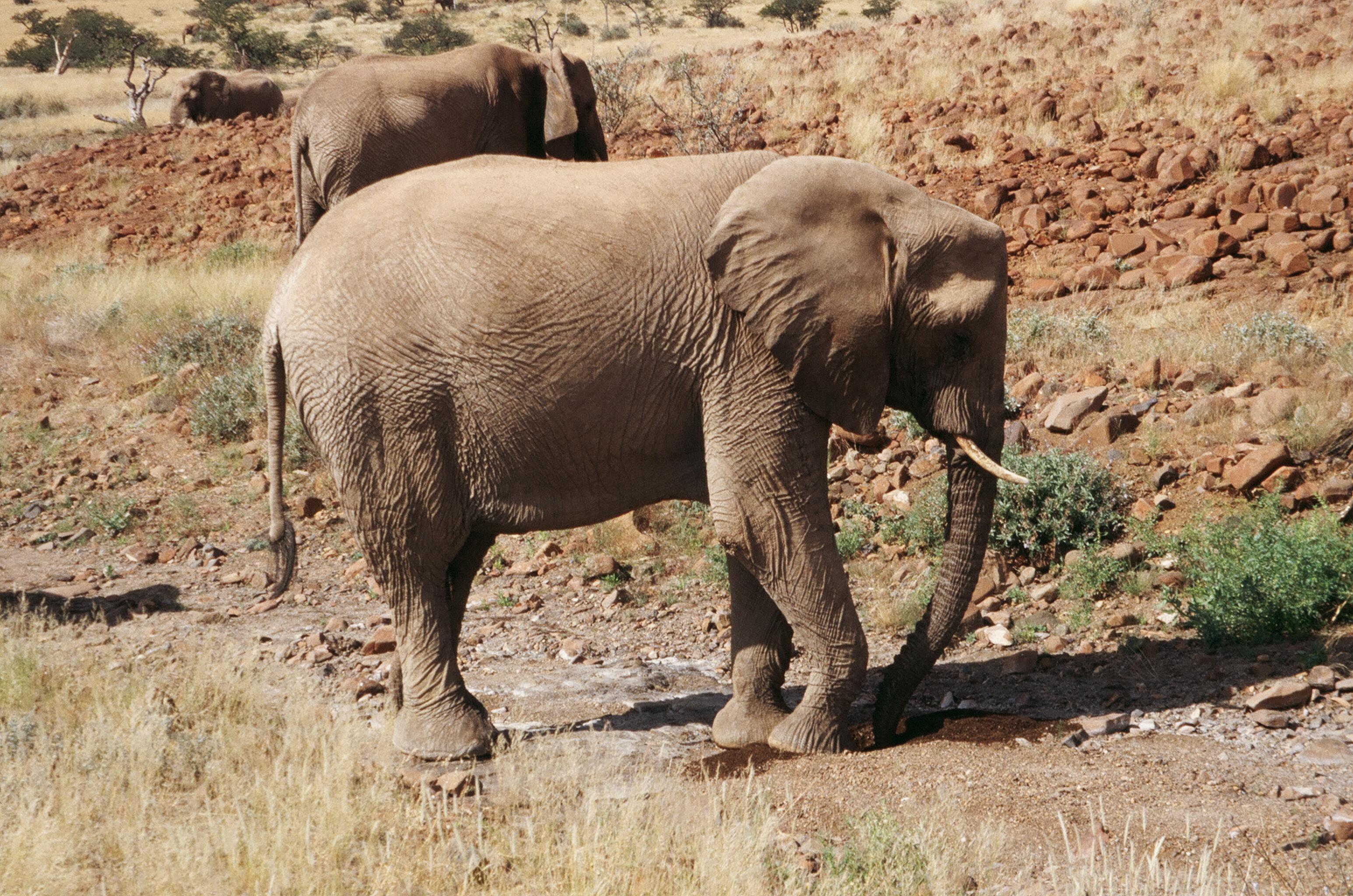 |
Red Dunes of the Namib Desert Desert-Adapted Elephant
The Damaraland camp was located in a rocky, mountainous region that looked like a moonscape. It is home to a remote herd of several hundred desert-adapted elephants, an endangered species, which migrated from the plains of East Africa many centuries ago and learned to survive in this arid, waterless environment. We were lucky to spot one herd of about twenty of these rare elephants from our Land Rover and spent three fascinating hours watching them as they climbed down a rocky cliff and dug trenches in a dry river bed with their enormous feet in search of water to suck up through their trunks.
The Ongava tented game is located on a large private game reserve outside of Etosha Park, Namibia’s largest game park. Although the more arid climate and sparse vegetation does not support the same large herds of animals that we had seen in Kenya, Tanzania and Botswana on earlier trips, it does have most of the major African wild game species such as elephants, lions, giraffe, rhino and many varieties of antelope. On the plus side, the lack of cover makes game viewing relatively easy in Etosha. Returning from a game drive at dusk, we stopped to watch a male lion escorting his females and two lion cubs over the landscape just as the sun was setting behind them. .But it wasn’t until the next morning in camp that we had our real close-up lion adventure.
We knew that the lions had entered our campsite throughout the night by the growling roars that echoed through the camp, sounding like they were coming from just outside out tent flaps. At dawn, as our friends in the next tent were preparing to walk to breakfast, escorted by an armed guide, a female lion gave a large roar and came charging at them from about two hundred feet away. It was only the quick action of the guide who, with his rifle loaded and pointed at the lion, was able to shout her off at the last moment, not more than twenty feet from the couple. He told us later that he was only a split second away from firing his rifle into the dirt at the lion’s feet. It was an exciting moment. If we had ever had doubts about the camp rules requiring armed guides to escort us to and from the dining tent, we became firm believers from that moment on.
I had a chance to ride in the co-pilot seat on our return flight to Windhoek. It was a quiet and almost surreal flight as we all gazed silently out the window at the dancing shadow of our little plane on the terrain below and reflected on our marvelous week in Namibia.
South Africa. Flying from Namibia to South Africa, we were met at the Johannesburg airport by Ron and Gay Baukol. It was another Stanley-Livingstone moment. On our 1994 visit to South Africa, Val and I had taken the Blue Train westward from Johannesburg to Capetown on the Atlantic coast. On this visit, we took a driving trip eastward to Durban on the Indian Ocean. Our guide was a 28 year old Afrikaner named Jan Jergens, who doubled as our driver for the 1, 800 mile road trip thru the Drakensburg Mountains to Kruger National Park, on through Swaziland and along the coast of the Indian Ocean to Durban.
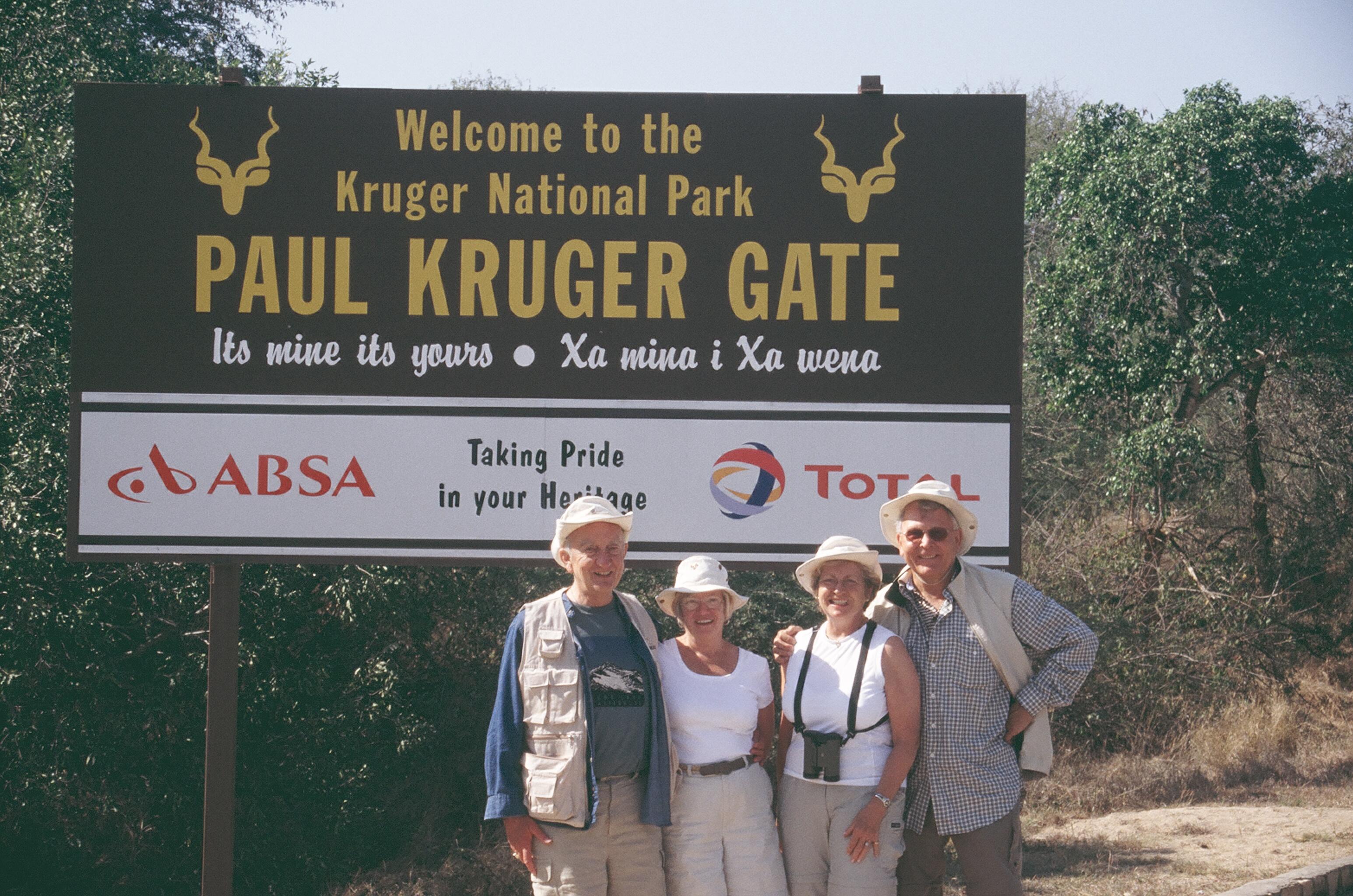 |
 |
Baukermans at Kruger National Park Male Lion
Kruger is the oldest and largest game park in Southern Africa covering over 7,600 square miles of low veld bush country. Its wildlife population statistics are breathtaking; a recent census showed the park was inhabited by over 7,600 elephants, 22,000 buffaloes, 31,000 zebras, 4,600 giraffes and more than 2,000 lions along with a thriving population of leopards, more than one hundred of the endangered black rhinos and countless other species. The area was set aside as a national park in 1898 by the South African President, Paul Kruger, just twenty-five years after the Yellowstone National Park was established in the United States.
We spent one night in Kruger and two nights in the adjacent Sabi Sands private game reserve, where we stayed at the exclusive Mala Mala camp, considered to be the premier safari destination in Southern Africa. Set in beautiful surroundings on the banks of the Sabi (Sand) River, the buildings are clustered under shady trees and manicured lawns. The individually decorated, spacious rooms under traditional thatched roofs enjoy spectacular views from their verandas and are each equipped with “his” and “hers” bathrooms, a first for us in all of our years of travel.
  |
Rhinoceros Leopard on the Hunt
As a private reserve, Mala Mala allows off-the-road- game viewing in open, four wheel drive Land Rovers, which makes it possible to approach the animals at very close range. During our daily early morning and late afternoon game drives, we were able to spot and photograph all of the so-called Big Five (lion, leopard, elephant, rhino and buffalo), most of the varieties of antelope from the tiny steenbok to the majestic kudu and sable antelope and, of course, all of our favorite storybook animals, including giraffes, zebras, hippos and monkeys, along with a long list of indigenous bird species. In Namibia and South Africa, we took close to a dozen, half-day game drives; each one proving more exciting than the last. Among the most thrilling were the several encounters in Sabi Sands with leopards, a truly magnificent animal, particularly from less than ten feet away.
Our route to the coast took us through the tiny, independent Kingdom of Swaziland, nestled in the mountains between South Africa and Mozambique. It is a picturesque country, sometimes called the “Switzerland of Africa”, which obtained its independence from Britain in 1968. A country of about a million people, it is ruled by the Swazi royal family. The current king, Mswati III, became king in the year of Swazi independence and has eleven wives. His father, King Sobhuza II, had 78 wives and 210 children. Unfortunately, the wealth that the monarchy has amassed does little to improve the life or health of the population in which over 40% of the adults are infected with the HIV virus.
 |
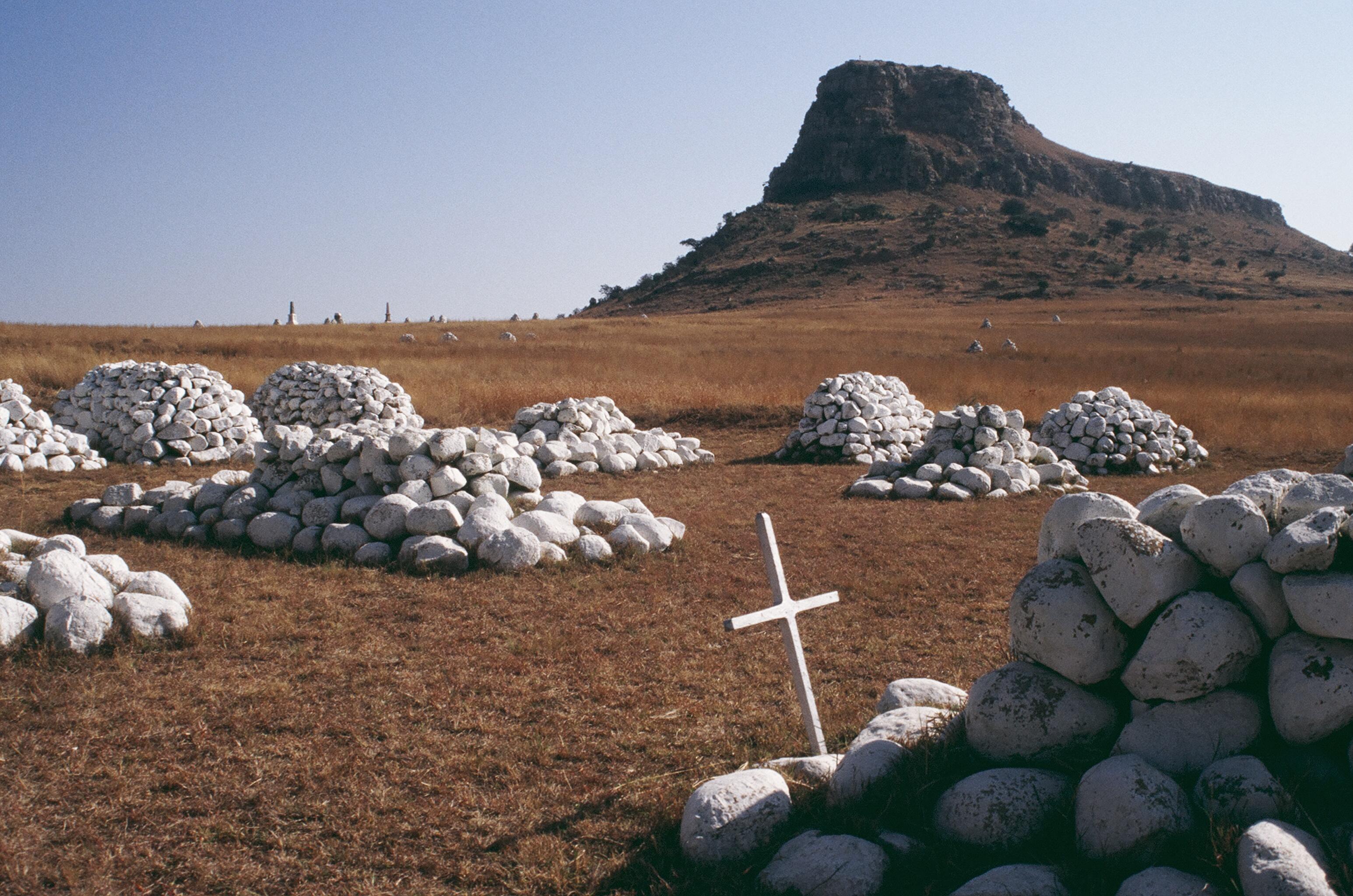 |
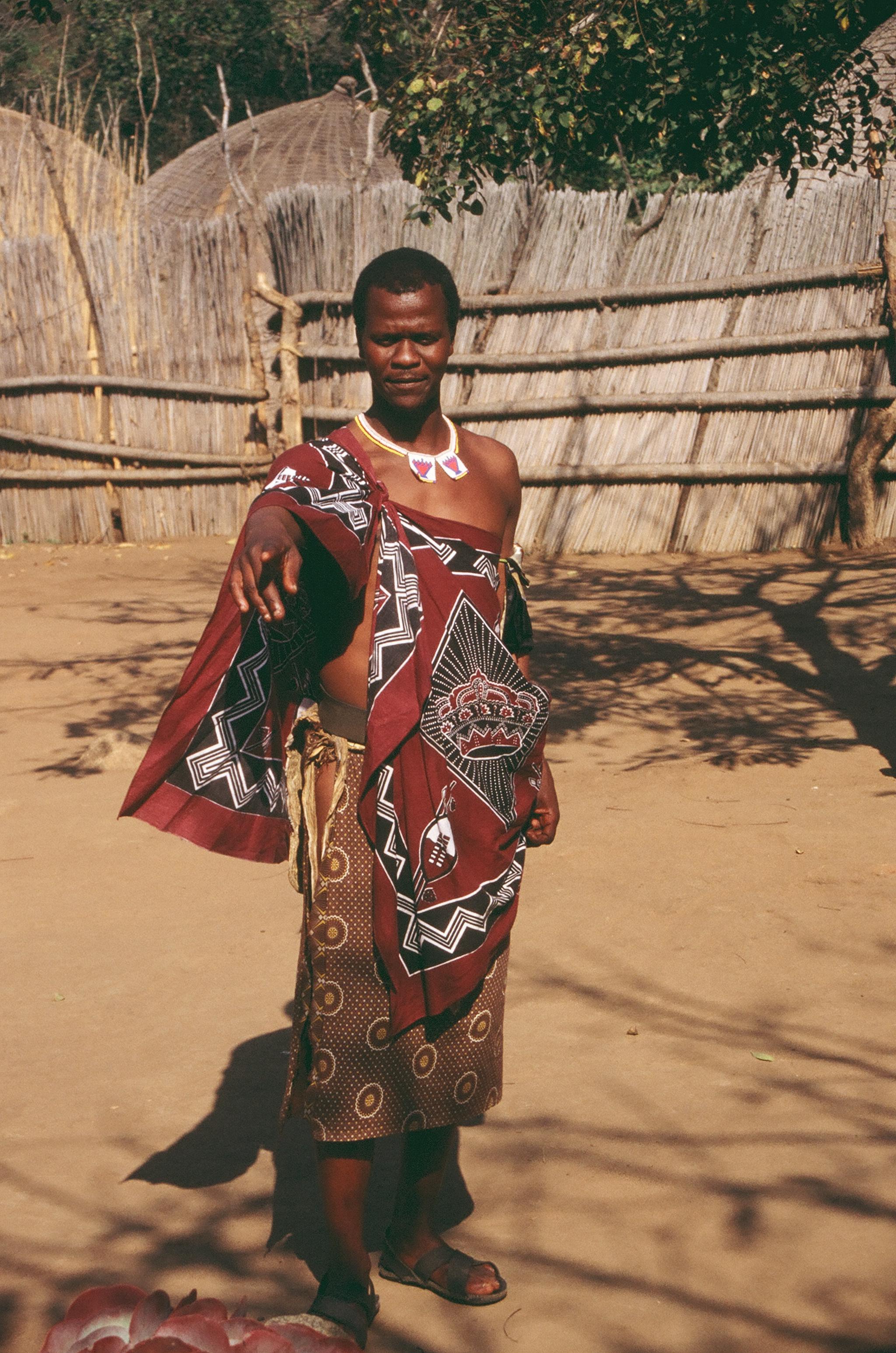 |
Giraffe in Mala Mala Anglo-Zulu Battleground, Islandlwana Swazi Warrior
From Swaziland, we drove to the coast at St. Lucia, the center of a World Heritage wetlands site, teeming with hippos, crocodiles and bird life. We used it as a base for a day trip to the battlegrounds of the Anglo-Zulu war. Having read the stories and seen the movies about the colorful history of the Zulu people, we were thrilled to explore the sites of the battle of Isandlwana and nearby Rourke’s Drift where the British forces were annihilated by an army of 40,000 Zulus in the worst defeat ever inflicted on the British army by native forces ("wild savages with spears"). All that remains today are piles of white stones marking where the 1,300 British soldiers fell in the battle of Isandlwana and the two small reconstructed buildings at Rourke’s Drift, where one hundred British soldiers successfully held off an attack of 4,000 Zulu later in the same day. The stories were brought to life by a great-grandson of one of those Zulu warriors, a local guide who recounted for us the stories of those heroic battles with great passion and drama, occasionally interjecting Zulu war cries to punctuate his tale. It was a spine-tingling retelling.
Our last two days were spent in Durban, a bright, bustling city of two and a half million people and South Africa’s largest seaport, where Ron attended the World Chambers Conference, a gathering of top business leaders from ninety countries around the world. As his “second wife” and “assistant” respectively, Valerie and I were able to participate in several of the events and tours, including a day trip to see some 3,000 year old Bushman cave paintings at Giant’s Castle in the Drakensberg Mountains. (It was only after our return home that I was to learn through a National Geographic DNA testing program that I am a direct descendent of these admirable people with my earliest ancestor dating back 40,000 years to that part of the world)
We flew home on the first day of the African winter, winging our way over the game parks of Southern Africa, the jungles of Central Africa and the sands of the Sahara before crossing the Mediterranean to Europe and on home to Minnesota just in time to welcome in our summer. Sadly we shall never be able to visit "Durban" again. In the near future, the city will officially change its name to its Zulu name, eThakwini, as Africa continues to turn away from its colonial past.